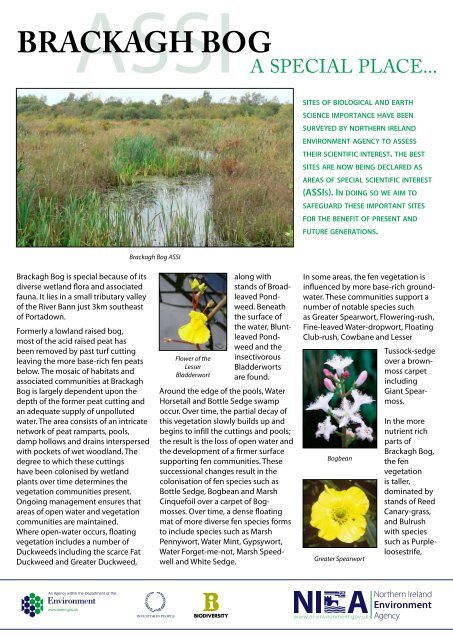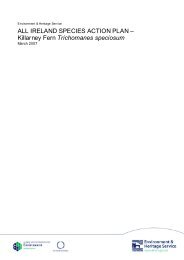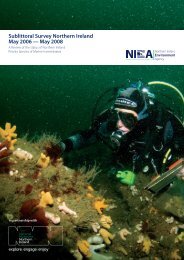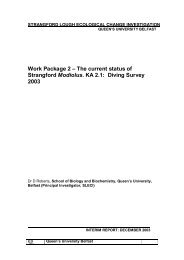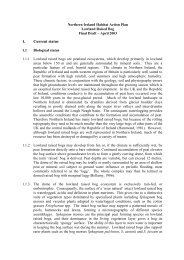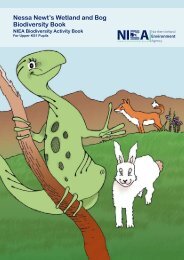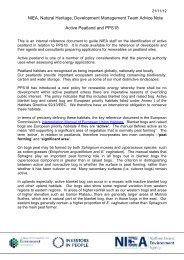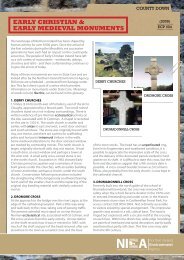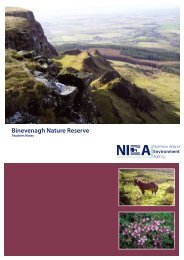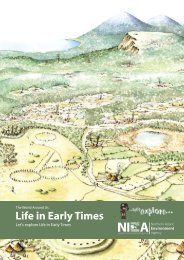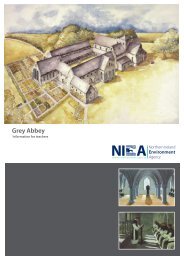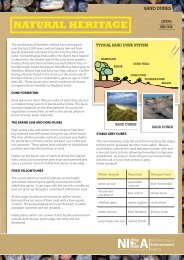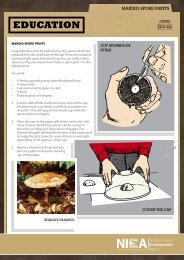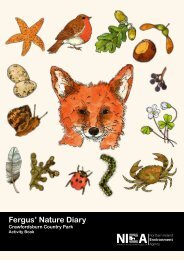Colour Leaflet of Brackagh Bog ASSI
Colour Leaflet of Brackagh Bog ASSI
Colour Leaflet of Brackagh Bog ASSI
You also want an ePaper? Increase the reach of your titles
YUMPU automatically turns print PDFs into web optimized ePapers that Google loves.
<strong>ASSI</strong> A<br />
BRACKAGH BOG<br />
<strong>Brackagh</strong> <strong>Bog</strong> is special because <strong>of</strong> its<br />
diverse wetland flora and associated<br />
fauna. It lies in a small tributary valley<br />
<strong>of</strong> the River Bann just 3km southeast<br />
<strong>of</strong> Portadown.<br />
Formerly a lowland raised bog,<br />
most <strong>of</strong> the acid raised peat has<br />
been removed by past turf cutting<br />
leaving the more base-rich fen peats<br />
below. The mosaic <strong>of</strong> habitats and<br />
associated communities at <strong>Brackagh</strong><br />
<strong>Bog</strong> is largely dependent upon the<br />
depth <strong>of</strong> the former peat cutting and<br />
an adequate supply <strong>of</strong> unpolluted<br />
water. The area consists <strong>of</strong> an intricate<br />
network <strong>of</strong> peat ramparts, pools,<br />
damp hollows and drains interspersed<br />
with pockets <strong>of</strong> wet woodland. The<br />
degree to which these cuttings<br />
have been colonised by wetland<br />
plants over time determines the<br />
vegetation communities present.<br />
Ongoing management ensures that<br />
areas <strong>of</strong> open water and vegetation<br />
communities are maintained.<br />
Where open-water occurs, floating<br />
vegetation includes a number <strong>of</strong><br />
Duckweeds including the scarce Fat<br />
Duckweed and Greater Duckweed,<br />
<strong>Brackagh</strong> <strong>Bog</strong> <strong>ASSI</strong><br />
Flower <strong>of</strong> the<br />
Lesser<br />
Bladderwort<br />
SPECIAL PLACE...<br />
along with<br />
stands <strong>of</strong> BroadleavedPondweed.<br />
Beneath<br />
the surface <strong>of</strong><br />
the water, BluntleavedPondweed<br />
and the<br />
insectivorous<br />
Bladderworts<br />
are found.<br />
Around the edge <strong>of</strong> the pools, Water<br />
Horsetail and Bottle Sedge swamp<br />
occur. Over time, the partial decay <strong>of</strong><br />
this vegetation slowly builds up and<br />
begins to infill the cuttings and pools;<br />
the result is the loss <strong>of</strong> open water and<br />
the development <strong>of</strong> a firmer surface<br />
supporting fen communities. These<br />
successional changes result in the<br />
colonisation <strong>of</strong> fen species such as<br />
Bottle Sedge, <strong>Bog</strong>bean and Marsh<br />
Cinquefoil over a carpet <strong>of</strong> <strong>Bog</strong>-<br />
mosses. Over time, a dense floating<br />
mat <strong>of</strong> more diverse fen species forms<br />
to include species such as Marsh<br />
Pennywort, Water Mint, Gypsywort,<br />
Water Forget-me-not, Marsh Speedwell<br />
and White Sedge.<br />
sites o f b i o l o g i c a l a n d ear th<br />
s c i e n ce i m p o r t a n c e h ave been<br />
sur veyed by n o r t h e r n i re l a n d<br />
environment a g e n c y to assess<br />
t h e i r scientific interest. t h e best<br />
sites are n o w b e i n g declared as<br />
areas o f special scientific interest<br />
(assis). in d o i n g so w e aim to<br />
s a fe g u a rd t h e s e i m p o r t a n t sites<br />
fo r t h e benefit o f present a n d<br />
f u t u re g e n e rat i o n s.<br />
In some areas, the fen vegetation is<br />
influenced by more base-rich groundwater.<br />
These communities support a<br />
number <strong>of</strong> notable species such<br />
as Greater Spearwort, Flowering-rush,<br />
Fine-leaved Water-dropwort, Floating<br />
Club-rush, Cowbane and Lesser<br />
<strong>Bog</strong>bean<br />
Greater Spearwort<br />
Tussock-sedge<br />
over a brownmoss<br />
carpet<br />
including<br />
Giant Spearmoss.<br />
In the more<br />
nutrient rich<br />
parts <strong>of</strong><br />
<strong>Brackagh</strong> <strong>Bog</strong>,<br />
the fen<br />
vegetation<br />
is taller,<br />
dominated by<br />
stands <strong>of</strong> Reed<br />
Canary-grass,<br />
and Bulrush<br />
with species<br />
such as Purpleloosestrife,
Yellow Loosestrife, Marsh<br />
Willowherb, Common Marsh-bedstraw<br />
and Wild Angelica. In drier areas,<br />
Meadowsweet, Yellow Iris and<br />
occasional Devil’s-bit Scabious,<br />
Common Knapweed and Carnation<br />
Sedge occur.<br />
Tall fen with Purple-loosestrife<br />
Between the cuttings, the drier ramparts<br />
support vegetation communities<br />
associated with deeper peat deposits<br />
including remnant bog vegetation<br />
with Common Cottongrass, Heather<br />
and <strong>Bog</strong> Asphodel.<br />
A range <strong>of</strong> wet woodland communities<br />
have developed into an intricate<br />
mosaic with the fen at <strong>Brackagh</strong> <strong>Bog</strong>.<br />
Some areas <strong>of</strong> wet woodland,<br />
particularly around the periphery <strong>of</strong><br />
the bog are permanently flooded.<br />
Willow with occasional Alder form the<br />
canopy with extensive stretches <strong>of</strong><br />
open water and exposed mud below.<br />
Duckweed is widespread on the<br />
surface <strong>of</strong> the water. Occasional<br />
mature Alder have died due to the<br />
high water levels, providing valuable<br />
standing dead wood habitat for<br />
invertebrate species.<br />
Other wet woodland communities<br />
have a partially open canopy and<br />
support a rich understorey <strong>of</strong> tall<br />
herbs and sedges dominated by<br />
Remote Sedge and Marsh Cinquefoil.<br />
Associated species include Common<br />
Sedge, <strong>Bog</strong>bean, Water Horsetail,<br />
Yellow Iris, Wild Angelica, Purpleloosestrife<br />
and Branched Bur-reed.<br />
More notable species, remnant <strong>of</strong><br />
the open fen communities include<br />
Royal Fern, Common Meadow-rue<br />
and Cowbane.<br />
Where wet woodland has developed<br />
on more acidic areas <strong>of</strong> fen, the<br />
ground flora is dominated by tussocks<br />
<strong>of</strong> Purple Moor-grass. Open water<br />
remains a large component <strong>of</strong> these<br />
wet woodlands where Downy Birch<br />
frequently occurs alongside the<br />
dominant Willow.<br />
<strong>Brackagh</strong> <strong>Bog</strong> is <strong>of</strong> national<br />
importance for its invertebrate<br />
communities supported by the wide<br />
range <strong>of</strong> wetland habitats. Of<br />
primary importance is the diverse<br />
moth fauna with over 150 species<br />
recorded, including 15 species <strong>of</strong><br />
note. Of particular importance is the<br />
Red-tipped Clearwing, a Northern<br />
Ireland priority species which has a<br />
well established colony at <strong>Brackagh</strong><br />
<strong>Bog</strong>. Other notable moths include the<br />
Valerian Pug, Figure <strong>of</strong> Eight, Satyr Pug<br />
and Lunar Hornet Moth.<br />
Red-tipped Clearwing<br />
Flooded wet woodland<br />
Beetles are also <strong>of</strong> significant interest<br />
with 14 notable carabid and water<br />
beetle species recorded at <strong>Brackagh</strong><br />
<strong>Bog</strong>. The range <strong>of</strong> pool types has also<br />
resulted in a diverse dragonfly and<br />
damselfly assemblage with 13<br />
species recorded since 2000. Typical<br />
fen species include the Hairy Dragonfly,<br />
Ruddy<br />
Darter,<br />
Common<br />
Hawker,<br />
Four-spotted<br />
Chaser<br />
as well as a<br />
range <strong>of</strong><br />
damselflies,<br />
including<br />
the Large<br />
Red<br />
Damselfly.<br />
Large Red Damselfly<br />
All <strong>of</strong> the habitats and species that<br />
make <strong>Brackagh</strong> <strong>Bog</strong> such a special<br />
place depend upon the <strong>ASSI</strong> being<br />
kept in good condition. We therefore<br />
need to protect it from certain<br />
activities which have been identified<br />
as potentially damaging to the site.<br />
The Northern Ireland Environment<br />
Agency is keen to work closely with<br />
all landowners/occupiers to maintain<br />
and enhance <strong>Brackagh</strong> <strong>Bog</strong> <strong>ASSI</strong>.


